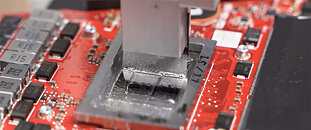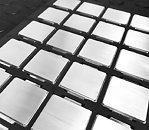
EK Shows Nucleus AIO CR360 for Direct-Die Water Cooling at CES 2024
During the CES 2024 show, EK unveiled an exciting new addition to their premium all-in-one (AIO) CPU cooler lineup—the EK-Nucleus AIO CR360 Direct Die D-RGB. As the name suggests, this new 360 mm AIO water cooler is purpose-built for direct die cooling of delidded Intel LGA1700 CPUs. The EK-Nucleus Direct Die stands out with its custom cold plate and mounting mechanism, which are exclusively engineered for exposed CPU dies. The nickel-plated copper base ensures compatibility with liquid metal TIMs like the included Thermal Grizzly Conductonaut, which comes in the package. EK has worked with der8auer to provide delidding service kits and tools to facilitate easy DIY removal of the integrated heat spreader (IHS).
The package also contains a contact frame and protective foam for safe liquid metal application. At the heart of the cooler is a powerful AIO pump EK co-developed with the OEM manufacturer, meaning it is not an off-the-shelf pump found in other AIOs and is capable of up to 500 L/h flow rate. The reinforced, sleeved rubber tubing is fitted with aluminium covers for durability. Integrated omnilink connectors allow daisy chaining of the three included 120 mm D-RGB fans for cable management. The EK-Nucleus Direct Die offers extensive RGB lighting customization with illuminated circle accents on the removable pump top covers. The diamond-cut brushed aluminium side panels and radiator cowl add to the premium aesthetic. The new AIO will be available for the Intel LGA1700 platform, with hopefully more versions later. The EK-Nucleus AIO CR360 Direct Die D-RGB is now available for pre-order at €202.90 MSRP price tag.
The package also contains a contact frame and protective foam for safe liquid metal application. At the heart of the cooler is a powerful AIO pump EK co-developed with the OEM manufacturer, meaning it is not an off-the-shelf pump found in other AIOs and is capable of up to 500 L/h flow rate. The reinforced, sleeved rubber tubing is fitted with aluminium covers for durability. Integrated omnilink connectors allow daisy chaining of the three included 120 mm D-RGB fans for cable management. The EK-Nucleus Direct Die offers extensive RGB lighting customization with illuminated circle accents on the removable pump top covers. The diamond-cut brushed aluminium side panels and radiator cowl add to the premium aesthetic. The new AIO will be available for the Intel LGA1700 platform, with hopefully more versions later. The EK-Nucleus AIO CR360 Direct Die D-RGB is now available for pre-order at €202.90 MSRP price tag.




















